|
[ Black Sea ] [ Climate ] [ Caves ] [ Archaeology ] [ Religion ] [ History ] [ Tourist Info ] [ Palaces ] [ Tourists' Comments ] [ Crimea ] [ Wines ] [ Meet our Team ] [ Services and Prices ] [ Mountains ] [ Hiking Trails ]
MEDIEVAL CAVE TOWNS
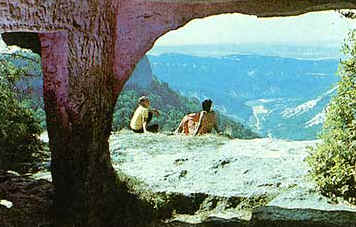
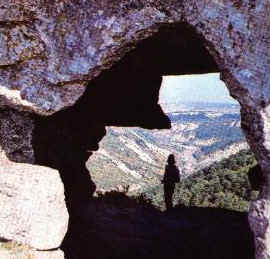
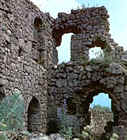
 A
tour of the cavern towns of Crimea offers an incredible glimpse into an
era richly filled with historical events. Cavern towns are surprising and
original monuments of medieval Crimean history and archaeology. A
tour of the cavern towns of Crimea offers an incredible glimpse into an
era richly filled with historical events. Cavern towns are surprising and
original monuments of medieval Crimean history and archaeology.
"Medieval cave towns" is a common name for monasteries,
well-fortified castles and towns.
They are found on the mesas of the inner ridge of the Crimean Mountains in
unique natural surroundings which in a small area concentrate numerous
natural wonders of mountains, woods gorges, and dizzy precipices.
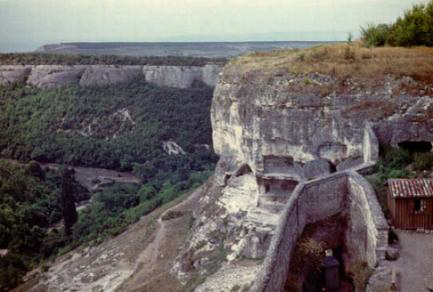 In
ancient times, it was dangerous to live in fertile and convenient valleys
since the Crimean peninsula suffered from the constant raids of nomadic
tribes. In
ancient times, it was dangerous to live in fertile and convenient valleys
since the Crimean peninsula suffered from the constant raids of nomadic
tribes.
Cavern towns are part of a defense structure enclosed with powerful
fortification walls with towers, caves, impregnable casemates, and natural
obstacles such as abrupt forbidding cliffs.
The cavern towns were built in the 6th-10th centuries by the multiethnic
populations which lived there.
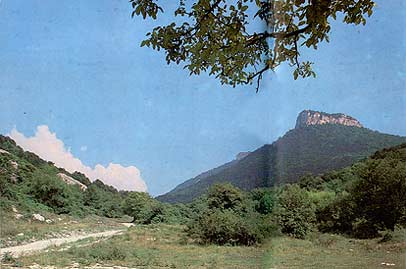 Crimean cavern towns have been divided by researchers into three
groups:
Crimean cavern towns have been divided by researchers into three
groups:
The first comprises towns of considerable area: Eski-Kermen, Mangoop,
Chufut-Kale, and Kyz-Kermen.
The second group includes well fortified fortresses-castles which
occupy small areas: Tepe-Kermen, Bakla, Siuyren Fortress, Kalamita,
Kyz-Kule and others.
The third group consist of Christian monasteries hewn into sheer cliff
faces: The Dormition Monastery, Chilter, Shuldan, Inkerman, Kachi-Kalyon,
to name a few..
Eski-Kermen
The cavern town "Eski-Kermen" was established in 6th century
A.D. It was a first rate fortress for its time. Eski-Kermen combined the
exceptional relief of the surroundings with fortifications built by human
hands.
One can see the ruins of this powerful fortifications walls, towers, and
cavern casemates connected with each other by tunnels and staircases.
Loop-holes are still visible 30 meters high from which arrows and rocks
were hurled at the enemy.
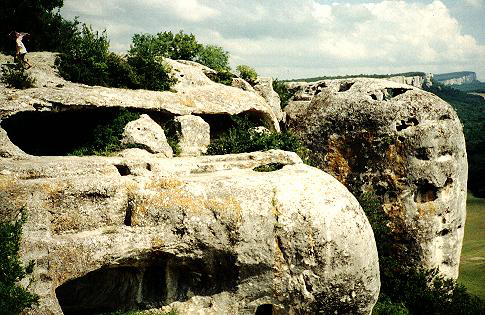
Casemates inside the cliffs in Eski-Kermen. |
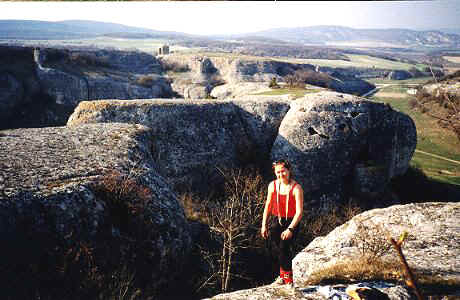 A
narrow pass between rocks was a part of the defense structure in the
cavern town Eski-Kermen. A
narrow pass between rocks was a part of the defense structure in the
cavern town Eski-Kermen.
|
 Eski-Kermen
was not only a fortress, but also a major center of trade, religion and
commerce. Agriculture, however, was the basis of its economy. Fertile
valleys were used to cultivate vines, vegetables and fruit. Eski-Kermen
was not only a fortress, but also a major center of trade, religion and
commerce. Agriculture, however, was the basis of its economy. Fertile
valleys were used to cultivate vines, vegetables and fruit.
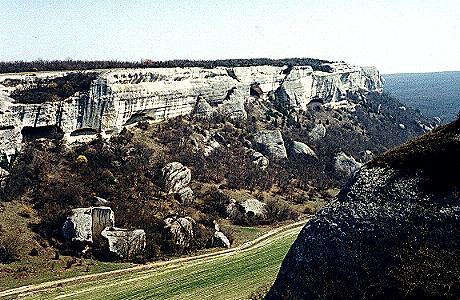 The
ancient trade way along the Eski-Kermen's walls. The
ancient trade way along the Eski-Kermen's walls. |
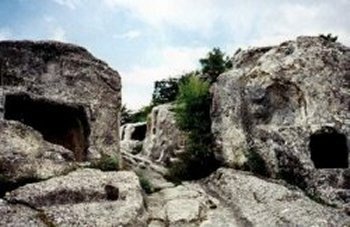 Tracks
of ancient vehicles at the main street. Eski-Kermen. Tracks
of ancient vehicles at the main street. Eski-Kermen.
|
Its powerful defense system, well developed economy for the time and
advantageous position made Eski-Kermen an important political and
administrative center in South-Western Crimea.
It retained its significance until the late 8th century, when an
insurrection of the local populations in the mountains of the Crimea
against the domination of the Khazars drastically changed the fate of the
town. The Khazars suppressed the uprising and having no need for
fortresses, they ruined the defense structures of Eski-Kermen.
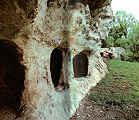 The
town continued to exist for another 500 years, but was finally laid to
waste in 1299 by the hordes of Emir Nogai. The
town continued to exist for another 500 years, but was finally laid to
waste in 1299 by the hordes of Emir Nogai.
Its population was almost entirely annihilated. The town never returned to
life.
Monasteries.
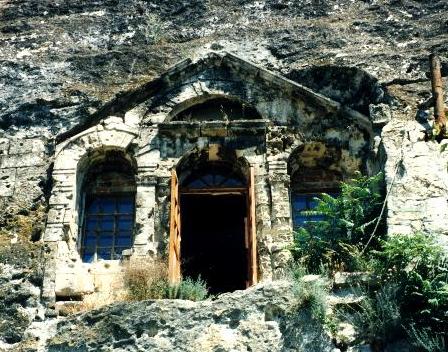 These had no special fortification structures. The caves contained monks
cells, churches, sacristies, burial vaults and other cult and husbandry
premises.
These had no special fortification structures. The caves contained monks
cells, churches, sacristies, burial vaults and other cult and husbandry
premises.
The history of cavern monasteries is very interesting. They appeared at
the turn of 9th century and their formation was to a great extent, an
outward manifestation of the political struggle between Byzantine secular
powers and monasteries which had accumulated enormous property.
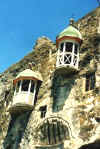 By accusing and then condemning the monks as idol and image worshipers,
the big monasteries were abolished, their property and lands passed to the
state, and monks were forced to marry or join the army.
By accusing and then condemning the monks as idol and image worshipers,
the big monasteries were abolished, their property and lands passed to the
state, and monks were forced to marry or join the army.
These drastic measures provoked the resentment of the monks and they
escaped to remote corners of the empire or went abroad.
Many of the fugitive monks gathered in the Crimea. It was they who
founded monasteries in the sheer cliffs along the rivers.
Cavern towns excite the interest of visitors and leave unforgettable
impressions because of the exotic location and appearance.
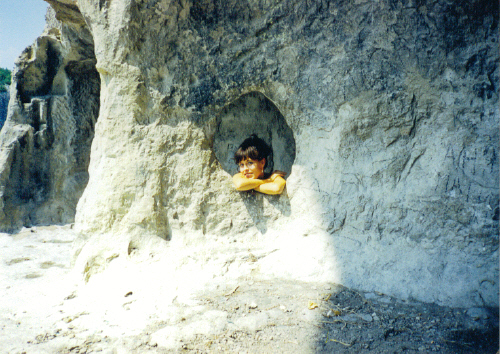
|



